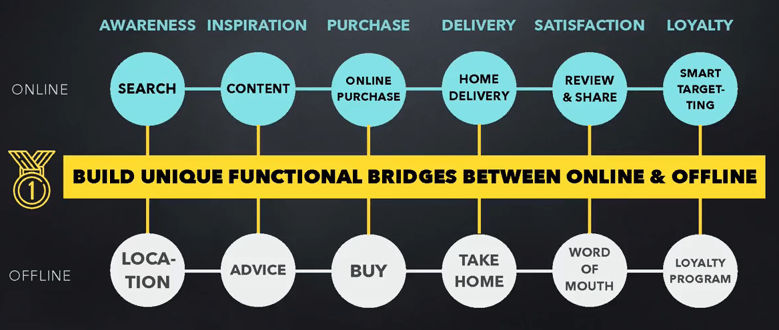
Are traditional retailers a dying breed? That is at least what some of them are starting to fear in sometimes desperate attempts to reinvent their businesses. So what is the answer to the relentless competition with purely digital players who are scooping up more and more market share? Going digital? Investing in physical channels? Omnichannel? In Jo Caudron’s recent keynote (in Dutch) at the Evolve Event at Google Belgium, he dived deeper into this pressing matter.
Go Digital?
To be on a par digitally with giants like Zalando or Amazon is simply not realistic. They have armies of developers at their disposal working on the constant improvement & innovation of their online platforms. Traditional retail would lose this battle before they even got started.
On the other side of the spectrum, a kiddy corner, groovy mood lights and an amazing cup of latte will not pull your customers back to your stores. Investing solely in physical channels results in a loss as well, taking into account that your customers are structurally visiting your stores less and less, not because of the ambiance but for fundamentally different reasons.
Omnichannel Retail?
Unfortunately, omnichannel also didn’t prove to be the all-in-one solution digital gurus had prophesied. It’s rather obvious that when I buy a piece of clothing online, my purchase will seamlessly be added to my offline loyalty card. This doesn’t add intrinsic value to my customer experience. It’s a given, customers expect it. Omnichannel is the prerequisite for mere participation in the game. It doesn’t get you qualified for the Champions League.
In the keynote above from the Evolve Event at Google Belgium, Jo Caudron, Co-founder of Duval Union Consulting, pitches the Hybrid Retail Model. This new strategic framework puts the emphasis on creating value and innovating on the bridges between online & offline, giving traditional retail a new competitive advantage against the Amazons of this world.
The Answer is Hybrid
In short this means that you try to identify functions (we call them ‘hybrid hacks’) that are valuable to clients and that can only be delivered because there is a physical network of shops with real, experienced and customer-centric people working in them. So it is not just about relying on the legacy of the physical network to save you, it is all about using your shops and people as a unique differentiator because the digital players simply do not have one themselves.
This can translate into anything that customers find relevant and enhances their overall experience. An example will clarify what we mean. If you have a product that is complicated (think consumer electronics), that you want to taste (think food, luxury items, …) or that you want to fit (think fashion) you can easily bridge the gap between online inspiration and information to expert advice in a shop nearby.
This way you have dozens of showrooms close to any customer, the only thing you have to do is identify the doubt or need online (maybe via chat) and fluidly push people from their online journey to the offline continuation and closure. As simple as this example might seem, no traditional retailer is doing this in a structural way. If the hack we just described is a USP towards your customers, just remember it is something Amazon simply cannot deliver. You win.
Discover your "Hybrid Hacks"
Depending on the kind of retail business you are in, you can come up with dozens of functions that could be relevant hybrid hacks.
Step 1: fix your digital capabilities by scanning, benchmarking & copying your digital rivals.
Step 2: innovate your physical points of sale in light of the Hybrid Retail Model.
Step 3: build functional bridges between online & offline, a hybrid space that digital native players simply can’t touch.


